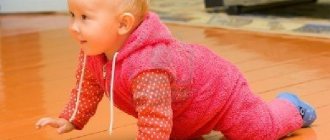Home › Child up to one year › Skill development
Author of the article
Ekaterina Rakitina Doctor Dietrich Bonhoeffer Klinikum, Germany
Reading time: 7 minutes
AA
Article last updated: 05/24/2019
Every parent tries to teach a child to crawl as soon as the baby’s age exceeds the normative period, when most children are already actively crawling. You need to understand that this skill is quite difficult for children, and not everyone can go through this period smoothly. That is why parents' help is welcome. But the goal of mom and dad should be support, not acceleration of development.
What to do if your baby doesn't crawl?
But what to do if all your efforts are unsuccessful and your baby refuses to crawl at 6, 7, 8, and even 9 months?
Of course, it may happen that your little one skips the crawling stage and immediately stands on its feet and walks for about a year, but doctors still advise in any case to consult an orthopedist, do therapeutic massage and exercises. If the orthopedist does not reveal any abnormalities, try the following:
- Invite a mother and a child who has already learned to crawl. Together they will have much more fun exploring the space. And if a little guest starts touching and playing with the owner’s toys, he is unlikely to watch this with indifference. Although your child is quite young, he already has a sense of ownership
- Crawl yourself, involve your grandparents, uncles, and aunts in this activity. Show by example how funny, fun and exciting it is.
- Create comfortable conditions for crawling. Make sure that the baby is comfortable on the floor: not cold and not hot. Dress your baby in comfortable clothes that do not restrict movement.
- Don't forget to do exercises and massage for your child. This will help your baby get stronger. You can do it yourself, or with the help of a qualified specialist.
What methods of crawling are there, their stages
A child can choose a convenient method of transportation for himself and use it contrary to the ideas of adults. Under no circumstances should you retrain your child.
Most children find it comfortable to crawl this way:
- spasmodically. The baby gets on all fours and rocks back and forth, and then suddenly jumps forward. This is an interesting method that many children use, but it is far from safe;
- in Plastun style. Standing on all fours, he crawls forward. At the same time, his body touches the floor.
- in reverse. Some children crawl backwards, which puzzles their parents. Neurologists even prescribe treatment for such babies, although official medical science does not consider this feature a deviation;
- rolling. This can hardly be called crawling; most likely, the cause is laziness and the desire to get an interesting item. This method is not the most correct, so the parents of such a child should intensively engage in gymnastics and massage with him;
- On knees. This is how 9-8 month old babies crawl. The baby's back is straight, and the hands set the pace of movement. The limbs move synchronously.
Safety precautions during training
Before you teach a child to crawl, you need to worry about his safety. To do this, go as low as possible and look at the room with baby eyes
What is important to consider for a comfortable crawling journey?
1. Correct temperature
The floor should not be too cool or too hot. And, of course, no drafts. If it’s still cold in the apartment, dress your child in warm, but comfortable clothes for movement.
2. Dangerous items
Particular dangers for the little explorer are corners, cabinet doors, and tablecloths on tables. Buy covers for furniture corners, block the doors, remove the tablecloth, which the baby can knock over along with heavy or sharp objects.
3.Height
This dangerous factor disappears if the baby moves on the carpet. Crawling on a sofa or bed requires parents to be near the baby. It’s good if a child falls and ends up with a bump and crying. What if a serious injury occurs or a fear of heights develops for life?
4. Electricity
We hide the wiring and cords, and put plugs on the sockets. Carefully scan the entire house for dangerous electrical appliances near your baby. They need to be raised or even hidden until better times.
6. Pets
Speaking of pets. They should be regularly examined by a veterinarian for parasites and worms. Kids usually get along well with cats and dogs, but aggressive animals should be kept away from the crawling toddler. Of course, ideally, the child himself should understand how to crawl. However, if your baby is unable to crawl, you can help him. Be patient and remember that even if you didn’t end up with a crawling baby, you prepared his body for the next stage - upright walking, by strengthening the muscles and developing the vestibular apparatus.
Baby crawling exercises
If a child at 6 months has mastered crawling “with his stomach”, but does not begin to crawl for real, this means that he does not know how to stand with his arms straightened, does not understand how to overcome the force of gravity in order to break away from the surface, or how to get on all fours . Parents can help him by performing various crawling exercises with the baby.
Let's deal with the hands. You can teach your baby to straighten his arms by hanging a flashy toy above his head while in the tummy position. The baby will be forced to stretch out his arms to reach it. Moreover, he will have to lean on one handle to take the toy with the other
Therefore, it is important that he uses each hand in turn. Another exercise is the “wheelbarrow” (many parents remember this from their childhood), it will teach the child to move with the help of straight arms. You need to support the baby by the hips or under the chest in a tummy position, straighten the arms and start pushing him forward
The baby will have to rearrange the handles. You can put an attractive “prey” in front of him in the form of a toy or treat. We use the vestibular apparatus. Balance is important for all mobility skills. Crawling is the first one. Therefore, it’s time to start active training. You need to lay the baby on his tummy on a cushion of blanket or towel. The arms remain free, so the baby should be encouraged to reach for the toys lying in front of him. Gently lifting the baby with the help of a wide towel, which is used to pick up the baby under the tummy, will help develop balance, while showing that gravity can be overcome. It should reach the floor, but not feel its weight. We get on all fours. You will need a large bolster made of a blanket - such that the baby, leaning his tummy on it, can stand with his straight arms and bent legs. Mastering the knees. If a child stands up straightening his legs, he needs to be taught to bend them at the knees. Supporting the baby under the chest, you need to lower him with bent legs onto a soft support (blanket, sofa) and slowly pull the baby forward. The baby will begin to move his bent legs. You can stimulate him to do this in another way. For example, place the handles on the blanket and lightly pull on it. Or place another object instead of a blanket that will slide along the floor (a book, a box). We teach to crawl. Dad's help is needed here. Let him move the legs of the baby standing on all fours, and let the mother move the arms. It’s good if the baby understands that he needs to crawl for something specific (his favorite toy). Example. Having taught your baby to stand on all fours, you can show him a clear example of crawling. The role of the “model” can be the mother or older children, if any.
Crawling training
The famous children's doctor E. O. Komarovsky is sure that a child is able to learn to crawl without the help of mom and dad. The task of adults is to develop their baby and maintain crawling skills. There is no need to interfere with the natural process, but strengthening the muscles is simply necessary. You can teach a child to crawl (at 8 months and older) by doing the following:
- massage, which can be done at the clinic, or you can call a massage therapist at home. Experienced parents can also do the massage themselves. To do this, you need to cross your arms on your chest, lift them, connect them with your legs, spread your arms and legs to the sides. Gentle pinching and stroking are also effective;
- crawling together. Already at 6 months, teaching a child to crawl is not difficult. It is ideal to practice on a bed or soft blanket. The baby should be placed on his stomach and a rolled up diaper should be placed under the chest. Then show the baby the toy, he should want to take it. You need to place your hand under the heels so that the baby can push off;
- a good example. When children have a role model, they learn everything quite quickly and easily. Both adults and other children can crawl. Once the skill is strengthened, the task can be made more difficult by placing obstacles in the children’s path.
How to teach a child to crawl correctly and how babies feel at the same time
Teach a child to crawl correctly photo When parents think about how to teach a child to crawl correctly, not all of them imagine how their baby feels.
Walking on all fours leaves marks on babies' delicate skin or they may bump into hard surfaces, so it's important to ensure there are soft surfaces on the floor. At the very beginning of training, it is best to use blankets
Touching the surface with hands and feet gives the baby the opportunity to develop tactile skills. How to teach a child to crawl correctly, giving him the opportunity to explore the world through touch? Create heterogeneous surfaces in its space. The unevenness of the coating will have a massage effect on the baby’s palms, and this is very useful.
Clothes for crawling are chosen as comfortable as possible. The child's movements should not be constrained.
Similar interesting articles:
The grasping reflex in newborns – when it manifests itself and how it develops.
Composition of DTP vaccine. Advantages and contraindications of DTP vaccination.
How to put a small child to sleep?
How to calculate the rate of weight gain in newborns
First aid kit for a newborn: composition and instructions for use
Flowering in newborns: causes, recommendations, treatment
How to teach a child to crawl?
There is no need to specifically teach until 7-8 months. Just place a bright, attractive toy in front of your baby while laying him on his tummy. He will try to reach it, straining all his muscles. And this is what is needed. Of course, age-appropriate gymnastics, massage and swimming should also be in the life of a baby of this period.
Watch the course “Child development from birth to 1 year” (free in ViLine.Club)
At 7-8 months, if the baby does not crawl on his own, help him:
- make a “leash” from a large scarf, stretch two ends under the armpits and one between the legs, grab the ends and lift the baby so that he can move his arms and legs - delight is guaranteed and crawling training too;
- put the baby with his tummy on a large ball and roll it around;
- praise, kiss, encourage.
As soon as the crawling mechanism becomes clear to the child and the muscles become stronger, he will crawl.
Gymnastics on fitball for infants
How to teach a baby to crawl
From a very early age, the child begins to explore his own body and its capabilities. And all this is in constant motion. At first, the newborn simply blinks, smiles, moves his legs and arms, and later he begins to crawl, sit up and, finally, take his first hesitant steps. Seemingly ordinary crawling is actually an excellent muscle workout, and this method of movement also helps the child develop harmoniously. Pediatricians unanimously claim that crawling is a preparatory stage before walking. While crawling, the muscles of the shoulder girdle, back, arms and legs will become stronger, and coordination will improve. In general, crawling is a must. But what to do if the baby is lazy and doesn’t want to crawl?
Remember that your child has just begun to discover this interesting new world, he needs to break away from his mother and start exploring the space and objects that are around. Give him a little more freedom, take him out of the crib or playpen more often, and put him on the floor. Sit down next to him: it will be much easier for the child when his mother or loved ones are in close proximity. Place toys or a ball at a short distance from the baby, he will reach for them, try to reach them and at the same time learn to crawl.
Here are some exercises to help teach your baby to crawl. As they say, it has been tested from personal experience and works even with very stubborn toddlers.
1. The first exercise will help you form support on straight arms - this is the main condition for starting to crawl on all fours. A six-month-old baby must learn not only to lift himself up in his arms, but also, preferably, to grab a toy with one hand while leaning on the other. If such a skill has not been developed, it is worth helping the child a little. To begin, place him on his stomach, and hang a toy in front of him, just above his head. To grab it, the child will rise in his arms and reach for the object that interests him. If suddenly the toy does not arouse interest, first let the child touch it, and then gradually lift it up.
2. This exercise will help strengthen the baby’s vestibular apparatus and teach him to work with his hands. Make a cushion from a blanket and place it under the baby’s chest (as in the first exercise, the baby lies on his stomach). The child's head and arms should hang from the roller, while the legs and stomach should be on a flat surface. In this position, the child can turn his head and grasp objects with both hands.
3. Learning to stand on all fours. For this exercise, you will again need a blanket bolster, but this time you need to place it under the baby’s belly and chest so that the arms and legs hang above the floor. In this case, the child will instinctively want to lean on them and will be forced to get on all fours.
4. This exercise will teach your child to crawl on all fours. to do it correctly, it is better to invite another adult assistant. Distribute roles in advance: one of the adults is responsible for the work of the child’s hands, the other for the legs
Then place the child on all fours on the floor with an attention-grabbing toy in front of him. Next, one of the adults moves the child’s left arm forward, the second moves the child’s right leg, and so on.
And don’t forget to set a positive example for your child. If the mother, or even better, another child, crawls in front of the baby on all fours, believe me, the little one will learn to move much faster on his own. And finally, a few training videos on this topic.
The technique is that the child is shown cards with all kinds of living and non-living creatures, letters and numbers. An adult shows each card for 1-2 seconds. As the child gets older, the number of cards and the duration of the lessons increases.
How to help your baby learn to crawl faster
If the child develops without deviations, then with the approval of the pediatrician, you can start training from 4 months. Earlier dates for starting classes can lead to complications, since the child’s shoulder girdle is not yet strong enough. Classes include massage and a set of exercises.
Before starting classes, you need to make sure that:
- the room is ventilated, temperature from 20 to 23ºС;
- at least 1 hour has passed since the last meal;
- The little one is in a good mood.
Massage and exercises are performed on a hard surface. You can spread a blanket and several diapers on the floor.
Classes are best done on the floor
Massage
Before starting the exercises, you need to give your baby a restorative massage using massage oil or baby cream. An adult's hands should be warm. For massage you can use a massage ball.
- With light movements we stroke the baby from the arms and legs to the center of the tummy.
- Lying on your back, alternately bring and spread your arms.
- The child lies on his back. We pull the straight left leg to the right shoulder, and the right leg to the left shoulder.
- Place the baby on the stomach. We stroke the back.
- "Angel". The baby is lying on his stomach. From the spine to the sides we stroke the back, outlining the wings. We do up to 30 strokes.
- From the lower back, move with smooth strokes to the armpits.
- "Train". We draw the edge of the palm several times along the spine, and then from the spine to the ribs.
- We pass the massage ball several times along the feet and from the palms to the shoulders.
Gymnastics for kids
After consultation with a pediatrician, gymnastics can include exercises with a fitball and a Doman track.
The main exercise on the ball is “Rolling the baby”: the baby lies on his tummy on the ball, an adult holds him by the legs and rocks him from side to side. The Doman track is a kind of trench, upholstered in soft fabric. The baby fits into it on his tummy; thanks to the narrow walls of the device, the baby reflexively repeats the movements that he made during childbirth. Classes with the Doman track can be carried out from 2 months, but only after consultation with a pediatrician.
Activities with your baby should be done every day
Lessons at 4 months
The purpose of the classes is to whet the baby’s interest in crawling and encourage the first attempts to crawl on its belly.
- "Bird." We take the child by the chest with both hands so that he looks down or forward. We lift and rock the baby from side to side.
- “Go to mom!” The child lies on the floor on his tummy. Mom sits a little far away, touches the baby’s upper lip (this activates his motor reflex) and calls him to her. The baby will struggle to crawl to his mother. Be sure to praise the little one and take him in your arms.
- "Forward!" The child lies on his stomach. We place our palm under our feet, the baby pushes off and moves forward.
- “What a toy!” Baby on tummy. A little distance away, a toy lies in front of him; an adult, talking about it and attracting the baby’s attention, encourages him to crawl towards the goal.
In order to crawl, a child must have a stimulus, for example, in the form of a toy.
Lessons at 5–6 months
If the baby has mastered crawling on his belly, then you can move on to new exercises aimed at mastering crawling on all fours.
- "Kitty." We place a tall cushion rolled out of a blanket under the baby’s tummy and chest. This position will reflexively force the child to lean on his legs and arms at the same time.
- "My toy!" We sit on the floor, spread our legs apart. We place the baby with his back up on one leg so that his legs lie on the other leg of the adult. It turns out to be an imitation of a pose on all fours. We put a toy in front of the baby and give him the opportunity to play with it. The child's body remembers its position in space.
- “Who is sitting with us?” The baby lies on his back, we take him by the arms and help him to a sitting position.
- "Bike". We alternately bend and straighten the baby’s legs, simulating riding a bicycle.
- "Top-top." We lay the baby on his back, perform forward movements with his feet, lowering them completely onto a hard surface.
- "Repeat". By six months, many children are already attempting to crawl on their own. If there are “sliders” among your friends, then you can invite them to visit: the child, following the example, will also want to move in the same way.
- "Labyrinth". This is the same exercise as “Come to Mom!” at the stage of mastering prone crawling, but at a new level. Now a “tunnel” of blankets, rugs, and towels leads to the goal.
The older children are, the more they try to imitate the actions of adults.
Classes for 7–8 months and older
The most effective exercise for children of this age is the “Repeat” exercise. Dr. Komarovsky offers a simplified option instead of inviting guests: mom or dad gets on all fours next to the baby and crawls, showing an example to follow.
If at 9 months the baby cannot crawl even on his belly, you need to show him to an orthopedist. If no deviations are identified during the examination, classes should be continued in the same mode: massage and gymnastics.
Video: how to teach a baby to crawl - recommendations from a physiotherapy instructor-methodologist
Video: how to help your baby learn to crawl - mom’s advice
The main thing is readiness
You can teach a child to crawl no earlier than his body is ready for it.
It is important to remember this and not harm it with excessive loads.
What does it mean - ready? This means that the child can:
- confidently hold your head in any position;
- keep your back straight in a sitting position;
- roll over on your tummy and back;
- make crawling movements while lying on your tummy.
In other words, the baby should have sufficiently strengthened all the muscles necessary for crawling. This happens at different times for different children. Some start crawling at 5 months, others at 7 or 8 months.
Therefore, if parents want their little one to quickly begin to explore the surrounding space, it is important to help him strengthen the necessary muscles in a timely manner. To do this, starting from 4 months, you can do a special set of exercises:
- strengthening massage;
- spreading the arms to the sides and then crossing them on the chest;
- turning on your tummy, lying in this position;
- flexion-extension of the arms;
- "bike";
- lifting the body (with support from the handles) in a prone position;
- alternate and joint flexion-extension of the legs;
- pushing off the mother's chest with the legs in a supine position;
- pushing off the legs from the support (arms), lying on the stomach;
- learning the skill of grasping objects (from the front, from above, from the sides) from a position on the stomach.
What needs to be done to teach a child to crawl?
First of all, it is necessary to surround the child with interesting, bright, varied objects in order to make him want to explore the space around him. These could be toys, pot lids, a cell phone, a TV remote control. It all depends on the child what he likes more. Encourage him to take action.
On average, babies begin to crawl at the age of 6-7 months, but it is necessary to prepare for this important process in advance. Here is a sample “action plan” to teach your baby to crawl:. 1
If at the age of 3 months your baby still doesn’t hold his head well, lay him out on his tummy more often and put bright objects in front of him, carry your baby around the apartment and show him various things. At the age of one, three and six months, be sure to visit a neurologist who will assess the condition of the child’s nervous system. You can also conduct a course of healing massage to strengthen the muscular system and stimulate motor development (especially if your child has muscle hyper- or hypotonicity)
1. If at the age of 3 months your baby still doesn’t hold his head well, lay him out on his tummy more often and put bright objects in front of him, carry your baby around the apartment and show him various things. At the age of one, three and six months, be sure to visit a neurologist who will assess the condition of the child’s nervous system. You can also conduct a course of healing massage to strengthen the muscular system and stimulate motor development (especially if your child has muscle hyper- or hypotonicity).
2. At the age of 4 months, surround the child with toys that are easy to grasp with hands. At this age, the baby begins to study the owl's body and suddenly discovers that he has legs - teach him to grab his legs and also reach them to his mouth.
When there are a lot of toys around a child (as in the photo above), one of them will definitely interest the baby and he will be forced to stretch, roll over or crawl to it
3. At the age of 5 months, the child begins to master space. To begin with, you can teach your child to turn on his side for an interesting toy, for example, a ringing rattle. Position the baby on his back, move his knee to the side so that he can complete the body rotation himself.
4. At the age of 6 months, also do not forget to engage in rotations and various kinds of turns. If the baby has not yet learned to sit on his own (normally this should happen at the age of 6 - 8 months), help him do this. The movement is carried out through the barrel, moving it with the handles.
5. At the age of 6-7 months, babies crawl on their own in some way: some on all fours, some on their bellies, some on their butts, etc. Before crawling, the baby first trains for several weeks: he gets on all fours and funny swings his butt. To provoke crawling, lure the baby lying on his tummy with toys or other objects he likes. Play various finger games with him (ladushki, magpie-crow), listen to funny children's songs with your baby that will make you want to move around. Children love to crawl over mom or dad, or crawl from mom to dad and back. Use it.
6. At the age of 8 months, the time of selfless crawling and attempts to stand with support begins. If at this age a child refuses to crawl or tries to get his way by screaming, this can be either a manifestation of character or a consequence of some motor difficulties. Encourage your child to reach objects independently. You can also conduct a repeat course of healing massage.
7. At the age of 9 months, almost all children really want to take a vertical position and stand on their feet from any position like a “vanka-stander.” If at this age your baby is still crawling, this is quite normal. The longer he crawls, the better. It will be worse if you force things and start leading your baby around the apartment by the hand, or even worse, use a walker for these purposes. Everything has its time. Give him plenty of room to move around and give him fun toys and things he wants to reach.
8. At the age of one year, almost all children can stand independently. However, every baby takes its first steps at its own time, when it is strong enough to do so.
We recommend watching this video on teaching a child to crawl
What if the child immediately begins to walk, skipping the crawling stage?
Parents wait for their baby to go and encourage him to do so in every possible way: they lead him by the hand, praise him, support him. Children learn well and as soon as they have the slightest opportunity to walk, they delight their parents with their first independent steps. It’s good when the baby is thin and light in weight. If a well-fed butt takes the first steps without crawling, the consequences appear quickly. The legs bend under the weight of the body. Simply, muscles and ligaments that are not properly trained cannot hold the legs in the correct position. It's not just the limbs that are affected. The architecture of the entire spinal column is disrupted. And here you go, early problems with the musculoskeletal system are guaranteed.
The second danger is that some interneuron connections do not have time to mature, which, according to neurologists, results in those very minimal brain dysfunctions that subsequently prevent children from studying calmly and mastering educational material well.
Different ways to crawl
Babies often surprise their parents. It is especially interesting to observe which crawling method they choose. The pose, speed, and pattern of rearrangement of limbs are suggested to them by the body and nature. That is why there are so many methods of movement in infancy. Let's look at some of them.
In Plastun style
The baby crawls on its tummy. It looks funny. He pushes off the floor like a wounded soldier, bracing himself with his knee and hands.
In this case, the legs bend alternately, and the arms simultaneously.
Reversing
The baby does not move forward, but crawls backward. This usually happens while sitting on all fours. Children hang their heads low and turn them in the direction of movement, keeping what is happening behind them under constant control.
Jumping crawl
The child gets on all fours, sways back and forth, gradually increasing the amplitude. Then he makes a small jump, lifting his legs and arms off the floor. Sometimes this method turns out to be dangerous. The child jumps unsuccessfully and hits his forehead on the carpet or nearby objects. You need to carefully monitor such a frog and wear a helmet for greater safety.
Rolling
The baby does not stand on all fours, but reaches the goal by rolling like a bun. At the same time, he knows exactly which side he needs to turn over in order to be near his mother or grab his favorite toy. Makes coups very skillfully.
On knees
The most convenient and safest method from the point of view of pediatricians and neurologists. The child leans on his limbs, first raises his right hand forward, takes a step with his left foot, and then changes limbs. Children come to this method gradually, improving movements by 7-8 months.
Organizing a safe crawl space
Every mother should get down on all fours in her apartment and look around with the eyes of her child. This will make clear all the dangerous places, obstacles and small objects that are lying on the floor and may end up in the baby’s mouth.
There should be fastenings on the furniture so that the baby cannot pull on the easily opened drawer and pour its contents onto his head. Also required are locks for doors, windows, toilet rims, as well as many other devices that can protect the child’s learning process.
Parents should understand that if the baby crawls and accidentally hits himself, he may get scared and stop striving to learn a new skill.
All sockets must have special plugs, and they must be difficult to get out of there. Under no circumstances should wires be within reach of a child. It is also better to hide all breakable, sharp and fragile objects, as well as chemical household products for cleaning and personal hygiene. All this should be upstairs, out of reach of the baby.
The child will crawl exactly when he hears the call of nature. There is no need to get ahead of or speed up the process. It is enough just to support the baby and give him freedom of action. Parental support and praise is very important for children. So they believe in themselves and try even harder. Komarovsky is right in this situation - the child should not live up to anyone’s expectations or written deadlines. He develops individually, and his parents should help him with this.
Read further:
When does a newborn baby begin to crawl and sit?
The main rules in the process of getting used to the potty
Teaching your child to use the potty independently
How not to do it
In order not to harm the baby’s health, it is important to remember what should not be done “for the good”.
- Use devices to maintain the vertical position of the child’s body: walkers, kangaroo backpacks, etc. These devices increase the load on the spine, which can lead to serious problems with the musculoskeletal system in the future.
- Get involved in games in the arena. The desire to crawl to an object of interest is a natural desire of a baby. The playpen limits space.
- Forcibly put the baby on all fours. This will cause a protest in the baby, and he will refuse to crawl for a long time.
- Worry if the child crawls backwards rather than forwards.
- Neglect massage before gymnastics.
It is important to remember that crawling is only useful when it is safe. Therefore, there should be no sharp objects, sockets, etc. near the “slider”.
Video: how to provide a safe crawling environment for your child - recommendations from Dr. Komarovsky
When babies start crawling
Motor development skills such as the ability to hold up one's head, sit up, crawl, stand up and walk in children appear at different times. There are average age standards for the development of these skills. But deviation from these standards does not mean that the child is behind in development, he just has this variant of the norm. Diseases that impair motor development are very rare, so most children go through all stages of development, including crawling.
Even when a child is three months old, laying him on his tummy, you can notice that he is trying to crawl on his stomach. Some children can already stand on all fours at 4-5 months, and at six months they begin to actively crawl. Others make their first attempts as early as 8-9 months. Pediatricians believe that the average time for a baby to start crawling is 6-10 months.
Large children, as a rule, move less actively, and they also develop this skill somewhat later than their peers. And if it comes to a premature baby, then its development standards shift even more. Therefore, such a baby may well begin to crawl at 10-11 months, even if he was born 2 months premature.
The benefits of crawling for a baby
Motor development is extremely important for full physical development. The benefits for the baby are many:
- crawling, the baby strengthens the skeletal system, as well as ligaments and muscles. This can help your baby learn to crawl, sit, and walk confidently. It also corrects possible deviations, for example, increased tone or torticollis;
- The physiological curvature of the spine is actively formed. A properly developed spinal column can withstand significant loads that occur when walking;
- coordination of movements improves, which allows the child to maintain balance, feel the rhythm of movement and move his limbs in a coordinated manner;
- the baby becomes more independent, as he has the opportunity to explore the world, touch objects of interest, etc.
There is no need to encourage the desire to walk before crawling. It shouldn’t be prohibited, but you can’t force it into a vertical position.
The age at which babies begin to crawl
In this case, one will be responsible for moving the legs, and the other will be responsible for moving the arms (one moves the right arm forward, and the other pushes the left leg, and vice versa). Show with your example how to crawl. From a very early age, the child begins to explore his own body and its capabilities. And all this is in constant motion. While crawling, the muscles of the shoulder girdle, back, arms and legs will become stronger, and coordination will improve.
Remember that your child has just begun to discover this interesting new world, he needs to break away from his mother and start exploring the space and objects that are around. Place toys or a ball at a short distance from the baby, he will reach for them, try to reach them and at the same time learn to crawl. 1. The first exercise will help you form support on straight arms - this is the main condition for starting to crawl on all fours.
We and our children
Authors : Nikitin B. and L.
But the crib has already been mastered inside and out. And on the floor, on a soft mattress covered with a large sheet, the first attempts are made to master the new space - the baby begins to crawl. We very soon - as soon as he could do it himself - allowed him to crawl from the mattress to the floor and “travel” throughout the house. This “liberation” turned out to be very useful for the development of movements. First of all, these are enormous (for him!) distances that must be overcome if you want to get to mom’s kitchen or dad’s workshop - what a lot of work for the arms, legs, and heart too, can you compare them with micro-movements in a crib . And these doors, whose handles are for some reason at an unattainable height, do not want to open, no matter how much effort you make. And those big legs of someone walking past or standing in the way - is it possible to cling to them? And all the items that seem to be made for giants. No matter how much you grab the ball, you can’t take it - your little hand slips, no matter how much you push this chair out of the way, it won’t move. It is difficult for a little person in such a new, unfamiliar, incomprehensible environment. However, these difficulties, apparently, are the most powerful engine of development, and if there is a father, or mother, or brothers and sisters nearby who will support the mood in case of failure, the baby tries to overcome them with amazing tenacity and incredible perseverance for such an age. In order for the child to learn to stand on his feet, we brought a frame from an old cot and placed it in the middle of the room on a rug or mattress. Holding onto the tubes of the frame (like a horizontal bar in a crib), you can rise and stomp around without letting go of the life-saving support from your hands. This is the second “sports equipment” that our baby mastered, and then, from about eight months on, it came to real sports equipment, which were right there in the room (rings, a crossbar, a rope with a punching bag at the bottom, a ladder, a horizontal rope across the entire sports room, etc.). We only lowered them to a height accessible to the baby and sometimes helped to catch the elusive ring. In this environment, and even in the company of older brothers and sisters, our “little sliders” quickly got used to it and began to move freely throughout the house. Naturally, the younger ones found themselves in better conditions than the first ones: our experience increased, more and more new sports equipment appeared, each of the younger ones had more “teachers” - older brothers and sisters. This had a very noticeable effect on the children’s development and affected the way they crawled. The result was even a kind of “diagram”: the first son used the usual crawling technique - he leaned on the floor with “six points”: his hands, knees and toes. The second managed to crawl only on one left knee, and put the other leg on the foot, that is, he walked “on all fours,” and the rest very quickly switched “to all fours,” that is, they not only walked, but also ran, without touching the floor with their knees. If we compare all these methods of crawling, then even to the inexperienced it will be obvious that the last of them is much more advanced than the others - it allows you to move much faster, but it also requires greater dexterity, strength, and endurance. This method can only be used by an active, strong child with good coordination of movements and the ability to reliably and quickly navigate in space. It is believed that crawling is, in general, an optional phase in the development of a child’s movements. There are children who manage without it, and nothing, they walk no worse than others. Maybe. But there are times when in games or sports exercises you need to crawl quickly and for a long time. This is much more difficult for someone who is not used to it: after all, other muscle groups are used here. In addition, while crawling, the arms develop and become stronger. In general, this is good gymnastics for a child’s comprehensive training and excellent preparation for future walking.
published 02/17/2007 12:35 updated 05/13/2011 — Child care, hygiene, Growth and development, Bathing and swimming
- ← Previous
- Next →
Conditions for skill development
Sometimes parents underestimate the importance of the developmental environment, relying solely on the internal strengths of the child’s body. However, adults can still create some conditions for developing the ability to crawl.
Space to move
The more free space you give your baby, the sooner he will start crawling. You should not rely on the playpen; it is better to clear the floor for the baby. Of course, before putting children on the carpet, remove all unsafe objects from the room.
Surface
The ideal option is a hard surface, such as a carpet or a hard blanket. Some parents purchase a specialized crawling mat. You should not place your baby on slippery linoleum or uncomfortable parquet floors. Wide double beds are also not suitable as they are too soft.
Obstacles
They are required after the child learns the simplest and even primitive manner of movement - on his tummy. By placing various barriers and obstacles along the baby’s path, you will “force” the baby to raise his body in order to move forward.
Interest
To encourage your baby to be physically active, try to interest him in a new or favorite toy; a kind of “bait” in the form of a pet is also suitable. That is, it is necessary to create many objects for research around the child.
Roller as a trainer
You will need it to teach your child to crawl on all fours. Such exercises will be useful for those kids who prefer to move on their bellies. Place your baby's tummy on the cushion and rock him back and forth. These movements will force the baby to rearrange his arms and push him to a real cross crawl.
When does a baby start crawling?
Parents should not think about what age their baby should crawl. He owes absolutely nothing to anyone. There are average statistical indicators, but children do not know them, so they live and develop according to an individual schedule.
It has been established that babies begin to crawl at 7 months, but some can master this skill at 5 months, and others at 10 months. Experts note that girls in this regard develop faster than boys by about a month.
When thinking about at what age the baby will crawl, you need to understand that there are several accompanying external and internal factors. The time to start mastering the skill depends on:
- from the floor (boys begin to crawl a little later than girls);
- from weight (well-fed babies crawl later than others);
- from full term (a premature baby will master the skill later than a full-term baby);
- on temperament (sanguine and choleric people learn the fastest);
- on health status;
- from the help of parents.
When a baby starts to crawl
Pediatricians call the crawling stage intermediate between rolling over and walking. Girls usually start crawling a little earlier, at 5–9 months, while boys show interest in crawling at 6–10 months. However, these dates are approximate, since all children develop, according to the famous pediatrician E. O. Komarovsky, according to an individual program. The age when a baby begins to learn to crawl also depends on:
- baby weight - it is more difficult for large babies to move, unlike thin peers;
- temperament - the calmer the child, the later he may become interested in crawling;
- the presence of complications during childbirth - if the baby had birth injuries, then the type of injury affects the speed of development of motor skills.
Video: why should a child crawl - the opinion of E. O. Komarovsky
Stages of crawling: on the belly and on all fours
“Sliders” master an important skill in stages.
- The first stage, which evokes affection among those around him, is crawling on his belly: the baby moves, lying on his tummy, leaning on his elbow, with one leg bent.
- The second stage is crawling on all fours. This stage precedes walking. Some children bypass this level of mastering crawling and go straight to walking. There is nothing terrible about this, but pediatricians consider such a “leap” undesirable: upright walking requires the muscles of the back and shoulder girdle to be sufficiently strengthened. This strengthening is facilitated by crawling on all fours.
Crawling for a child is also an important stage in mastering the world around him.
How to tell if your baby is ready to crawl
Factors of readiness to crawl are the following signs:
- baby holds his head;
- knows how to roll over;
- reaches for a toy;
- tries to lift himself up on his arms;
- sitting or trying to sit.
How to teach a baby to crawl at 5 months
As Komarovsky notes, it is important not only how much time you spend with your child, but also the regularity of the activities. The doctor recommends not using a walker or helping the child sit down and stand up, since the parents’ task is to encourage the child to independently learn new motor skills
After making sure that the child is developing correctly, from five months you can prepare the baby for crawling. If the child does not begin to try to crawl at least a little, the baby can be taught to crawl by doing special exercises with him. Children have different temperaments, so a fidgety and restless explorer begins to crawl at 5 months, and a calm or lazy toddler can crawl at 8 months.
The entry was published in the Book category and tagged Breast. Bookmark the permalink.










